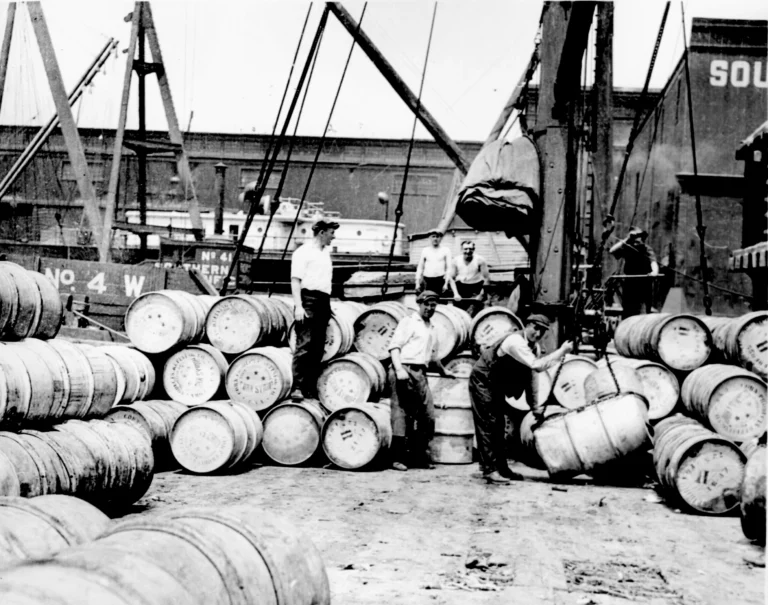SS Glückauf - The World First Modern Tanker Ship
But in 1886, everything changed with the launch of the SS GLÜCKAUF, the world’s first modern tanker ship, marking new era in maritime history.
By Pranala Digital Transmaritim
15 January 2025
Once upon a time, transporting crude oil meant using barrels on conventional cargo ships a risky and inefficient method. But in 1886, everything changed with the launch of the SS GLÜCKAUF, the world’s first modern tanker ship.
Built by the Armstrong Mitchell & Co. shipyard in Newcastle, England, for the German company G. H. W. Kortum, this remarkable ship was designed specifically to carry oil safely and efficiently, marking the dawn of a new era in maritime history. SS GLÜCKAUF wasn’t just a ship, it was a breakthrough that set the stage for the entire oil shipping industry we know today. Let’s take a moment to appreciate how far we’ve come and remember that history is full of fascinating moments that shape our world.

Stevedores on a New York dock loading barrels of corn syrup onto a barge on the Hudson River (1912). Photo: Lewis Hine
Background
Before SS GLÜCKAUF born, crude oil was transported in barrels or drums using conventional cargo ships, a method that was inefficient and posed significant risks of spillage and fire. The growing demand for transporting large quantities of oil prompted German company G. H. W. Kortum to commission a purpose-built tanker from the Armstrong Mitchell & Co. shipyard in Newcastle upon Tyne, England.
During its construction, the ship was initially called SS ADVANCE, a project name used by the Armstrong Mitchell shipyard. It was later renamed SS GLÜCKAUF when delivered to its owner, the German company G. H. W. Kortum.

SS Glückauf Drawing (1886). Photo: Auke Visser’s German Esso Tanker’s site
Technical Details
The ship measured 91 meters in length, 11.6 meters in beam, and had a draft of 7.3 meters. It had a gross tonnage of 2,307 tons. The vessel featured nine integrated cargo tanks, constructed from steel, with a total oil capacity of 2,307 tons.
Powered by a triple expansion steam engine and coal-fired boilers, she had a maximum speed of 9 knots. Its flat-deck layout and minimal superstructure were designed for optimal cargo handling and safety, including fire prevention measures and segregated coal bunkers. It was also equipped with traditional navigation tools such as compasses and sextants.
Operational Service
In the German name, SS GLUCKAUF meaning “good luck” or “fortune,” reflected the owner’s aspirations for success and prosperity with this revolutionary oil tanker. SS GLÜCKAUF began service in August 1886, marking a new era in oil transportation as the first vessel designed to carry crude oil in bulk. It primarily operated on transatlantic routes, transporting oil from the Pennsylvania oil fields via ports in New York and Philadelphia to major European destinations, including Hamburg, Bremen, and London. The ship’s innovative design, featuring a double hull and integrated steel cargo tanks, significantly improved safety and efficiency, setting a new standard for the oil shipping industry.

German tanker Glückauf stranded on 23/24 March 1893 in heavy fog at Blue Point Beach at Fire Island. Tourists were common at the wreck site for years after. (1886). Photo: Benjamin T. West
Accident And Final Fate
In 1893, SS GLÜCKAUF met a tragic end after serving for seven years when was on a charter voyage for the Standard Oil Company. The vessel struck a reef off Fire Island, New York, United States, during poor weather conditions, sustaining severe damage to its hull. Although no lives were lost, the ship was declared a total loss, and its cargo spilled into the ocean, marking one of the earliest recorded oil spills in history.
The wreck was abandoned at the site, where it became a tourist attraction for many years. Over time, it gradually deteriorated due to corrosion and the natural forces of the sea. The wreck of the GLÜCKAUF now lies 75–100 feet (23–30 m) offshore, from the water surface to 25 feet (7.6 m) of water, eventually fading away, yet still remembered for its pioneering role in oil transportation.
Read this article on LinkedIn
